Social Realism, New Masses & Diego Rivera
Self-expression and anarchist individuality were the result of isolation and alienation of the artist in a developing capitalist society. Art had become a commodity like any other commodity on the market, and the artist had sold himself as well as his picture.
It was the 1920’s and artistic discoveries were prosperous. The extremity of fascist regimes were amplified as well as racial conflict and the intensification of economic depression, this also initiated an optimistic reaction from the public after both the Mexican and Russian revolutions. Within the above historical context of the effects of the great depression of 1929, a very large and diverse group of artists later called the Social Realists joined together to publish magazines, organize unions and convene artists’ congresses. The social realists publicly agitated for the importance of their revolutionary work, the role of the artist within society, and radical anti-capitalistic change for the world. Social Realism established a political purpose crafting emblematic and representative images of the masses, The Masses embodied the low and working class, labor unionists and politically disenfranchised. American artists found their purpose in the belief that art was a weapon to fight the capitalist exploitation of workers and halt the expansion of international fascism.
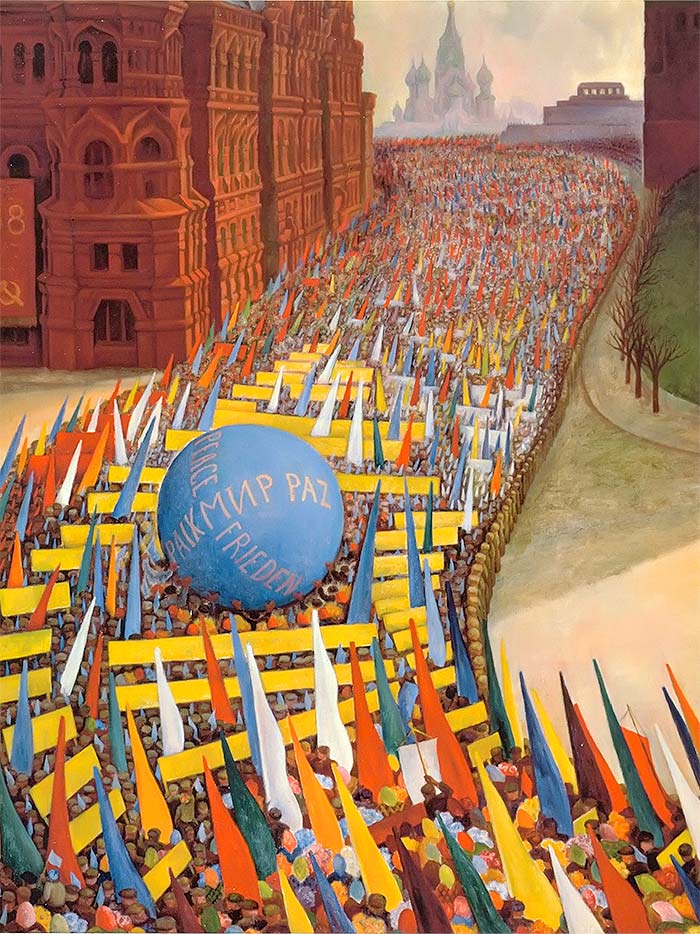
Social Realists resonated with the laborers and workers of their society, the artist’s role was to both portray and inspire their actions. The social realist artist was not to practice the self-indulgent self expression encouraged by a decadent capitalism for its own jaded amusement instead, they were to use their freedom to interpret the aspirations of a free people. Mexican muralists, namely, José Clemente Oroszo, Diego Rivera, and David Alfaro Siqueiros were examples of this artistic interpretation. These social realists endeavoured to employ art to protest capitalist exploitation and dramatize injustice to the working class so therefore was essentially anti-establishment.
The Social Realist artist symbolized unity within the working class, personifying themselves as critical members of society. Social Realists built on the legacies of Honore Daumier, Gustave Courbet and Francisco Goya in their politically charged and radical social critiques. While modernism is most often considered in terms of stylistic innovation, social realists believed that the political content of their work made it modern.
New Masses
The emergence of leftist politics inspired politically motivated social realist artists and journalists to launch New Masses (est. 1926), a progressive cultural magazine that was tied to Communist Russia. These pioneering artists also established the John Reed Club, influenced by American journalist and communist activist John Reed, the magazine itself paid homage to Reed who chronicled the Russian Revolution. Max Weber was a prominent member and was arguably a pioneer of social theory and the rapidly evolving 20th century. Weber, alongside Karl Marx and Emil Durkheim were said to have been principal founding-fathers of modern social science, contributing to the birth of new academic discipline of sociology. Weber is, to this day, claimed as a source of inspiration by empirical positivists.
Other familiar contributors of the John Reed Club were (artist and political activist) William Groper, Hugo Gellert, Moses Soyer and Raphael Soyer. The teachers of the club initially included the Mexican muralist David Alfaro, theorist Lewis Mumford, art historian Meyer Schapiro, artist Ben Shahn, and Louise Lozowick who was the main theorist of the group. The club never dictated a specific artistic style or subject matter, yet mandated that artists align themselves with the poor and dispossessed, fight for racial justice, and oppose fascism. The New Masses and its descendant the John Reed Club were radical organizations motivated by Marxist-Leninist ideology the Communist parties at that time during the late twenties and early thirties. The New Masses was closely associated with the Communist Party in the United States. America was becoming more and more receptive to ideas from the Leftist politics with the immersion of the Great Depression in 1929 and The New Masses became highly influential in intellectual circles.
A Monthly magazine was published and its purpose was to express artistic innovation.
“Sympathy and allegiance unqualifiedly with the international labour movement but were said to have no connection with any political party. A magazine of arts and letters, interpretive of American life: interested in the struggle, and in the stimulation of imaginative works created out of the new civilization.”
Virginia Hagelstein Marquardt, The Journal of Decorative and Propaganda Arts
Vol. 12 (Spring, 1989)
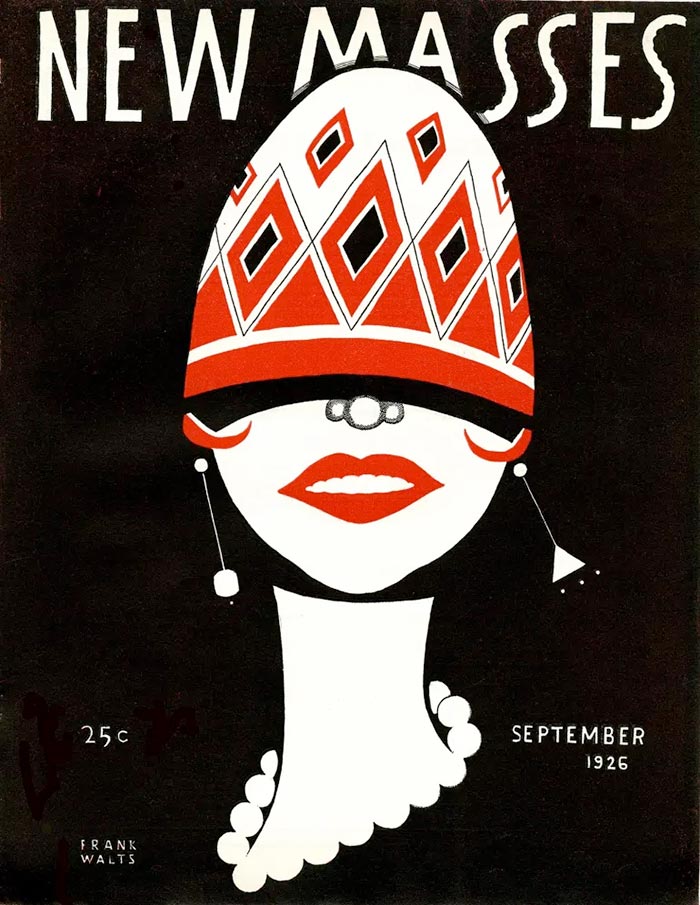
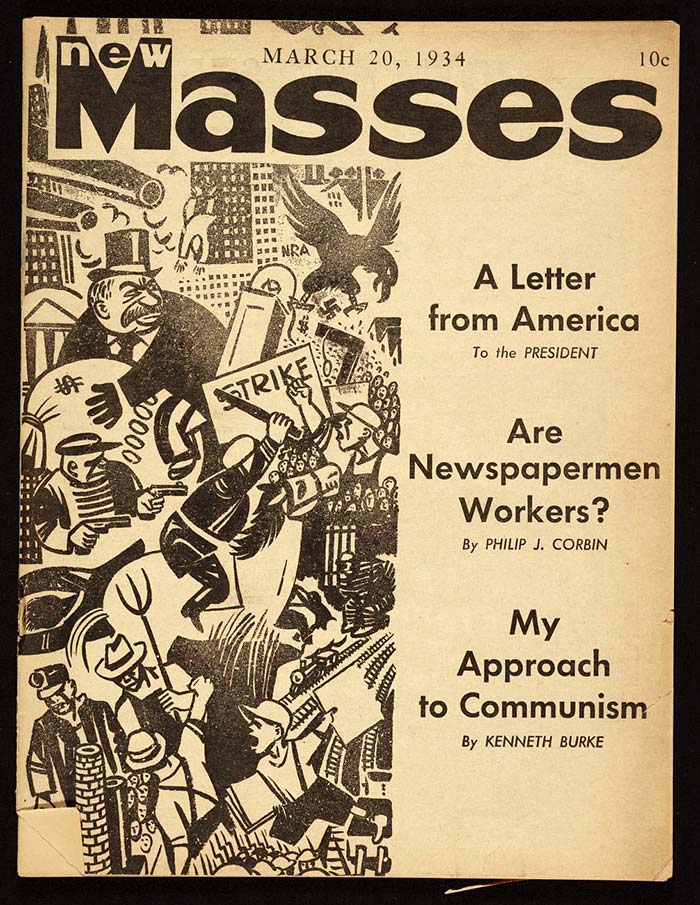
New Masses proposed its publication would welcome the expressions of all schools and regularly interpret the activities of workers, farmers, strikers and major members of the public whilst prioritizing high standards of literature written by capable editors. They also endeavoured to strike its roots strongly into American reality and disclose a significant cultural and human movement, publishing stories, pictures, poems, satirical cartoons and criticisms. New Masses presented that at least half of the pages will consist of pictures of current political and social events based on the emotion of art.
Mexican revolution
A largely positive aspect of art was the art of the people, they were believed to embody everything, pure and rich. Most artists had experienced and felt the reality of labouring and living among the working masses. The Mexican Revolution had begun in 1910 emerging originally as a middle class revolt led by patrician Francisco Madero, against the degrading regime of President Porfirio Diaz. Diaz was said to establish expeditious industrialization, submit to the control of foreign capital and, to a potentially disastrous degree form new laws designed to return the land to private ownership, essentially undoing the land reforms of previous president and favoured ideal Benito Juarez. Most of Mexico’s land was owned by wealthy landowners, 20 percent was in foreign hands, and many peasants and urban workers were living in dire poverty. The harsh reality of the revolution influenced the people of Mexico to turn to art in order to express their feelings and beliefs towards the revolt.
Mexican muralism was an artistic combination of artistic influences which resonated the history of the Mexican people such as Catholic conquistadors and Aztec wall painting. A movement named Los Tres Grandes prominently involving Diego Rivera, Jose Clemente and David Siqueiros was established; these influential Mexican muralists aimed to relieve and express the suppressed emotion of the Mexican people.
Rivera’s paintings and murals
Rivera was an impressively prolific Mexican Muralist coating walls with imaginings of invention and revolt, he devoted himself to an art of complete social eloquence. Rivera held tremendous success but also faced harsh controversy, for both his political beliefs and artistic subject.
“The scope of Rivera’s art, and the national prestige it still enjoys in Mexico, came from special historical circumstances; the Mexican masses, like those of Russia, were pre-electronic, low literacy, and used to consulting popular devotional art as a prime source of moral instruction.”
Robert Hughes, Art Critic and Author of The Shock of the New
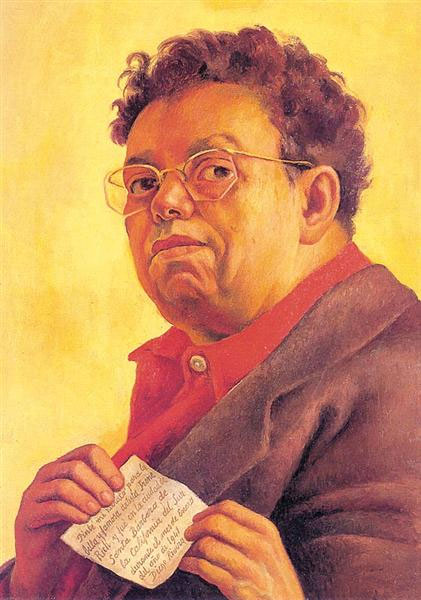
Diego Rivera was an influential and distinguished Social Realist, he is recognized for his incredible larger than life paintings, his exuberant disposition in correlation to his vigor for Communist politics and his tempestuous relationship with the renowned and honoured artist Frida Kahlo. Rivera is said to have a large zest for life and it is apparent that he was a habitual womanizer and a pure visionary, he desired to represent the social ideas of the Mexican Revolution visually and he found that the format of muralism as it existed only publicly, for the celebration, education, and edification of the ‘people’. It told the people of the masses’ story in a format that retained intense emotional resonance. His depiction of the poor, oppressed workers with great dignity and beauty resonating his sympathetic handling.
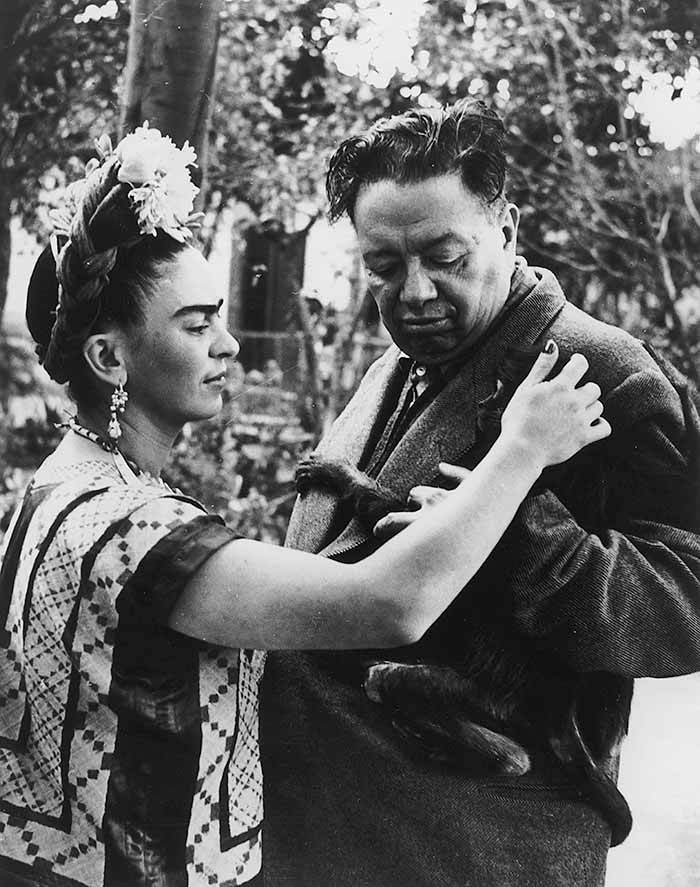
Photo: Wallace Marly/Hutton Archive (Undated) Biography.com
As a favourable and much desired artist, Rivera’s paintings embarked on a series of trips to the United States. The Mexican Communist was invited by three bastions of capitalism to create substantial murals on their behalf, this was considered highly controversial among other social realist artists and the public. The interchanging of cultural schemes, art, and the public between Mexico and America had an impact on their individual cultures. Idealistic stereotypes of one another were the result of the juxtaposition between the two countries. This however, led to their union and the sharing of one another’s ideas was said to be reconstructive. Riveras depiction of workers united nationally and crossing borders in his murals evince how Mexicans and Americans could benefit by learning from each other.
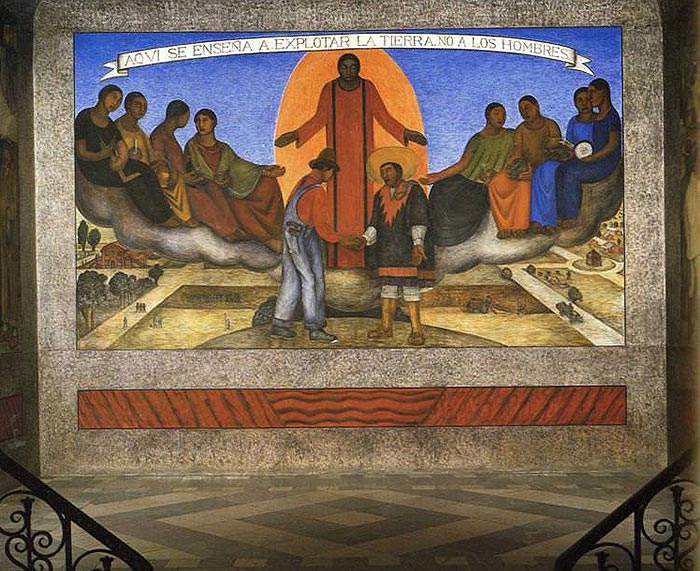
Diana Loercher Pazicky expresses the wave of populist fervor swept over Mexico and found pictorial expression in hands of muralists such as Diego Rivera, this was a repercussion from the Mexican Revolution which chipped away at the repressive oligarchic regime and gradually brought about agrarian, educational, and labor reforms during the second decade of this century.
“Mexican muralism has not brought anything new to the universal plastic arts, nor to architecture, and even less to sculpture. But Mexican muralism — for the first time in the history of monumental painting — ceased to use gods, kings, chiefs of state, heroic generals, etc. as central heroes . . . . For the first time in the history of art, Mexican mural painting made the masses the hero of monumental art. That is to say, the man of the fields, of the factories, of the cities, and towns. When a hero appears among the people, it is clearly as part of the people and as one of them.’’
Diego Rivera
The objective of the mural “Man at the Crossroads” was initially to illustrate and portray through imagery the social, political, industrial and scientific possibilities of the 20th century. The depiction of Vladimir Ilyich Lenin leading a mayday parade disgruntled the Rockefeller’s, a prominent wealthy banking family and provoked their demand for him to remove it. Rivera refused and they then fired him, though they did pay him in full, and destroyed the mural. Rivera encourages juxtaposition between the two sides, we notice a capitalist side that encompasses the brutalities of World War I, he discloses the use of technology that the capitalist nations use as destructive forces. In contrast the right communist side reflects the splendor of the Russian Revolution, Rivera distinguishes key figures in the workers movement such as Karl Marx and Leon Trotsky.

(Khan Academy)

Rivera critiques traditional art history on the other side of the composition, placing another classical sculpture revealed as Zeus, the supreme Greek god. Rivera questions the political elite (that—in his view) —had repressed the popular masses throughout human history. Though Rivera enjoyed tremendous success, he also faced harsh controversy, for both his political beliefs and artistic practice.
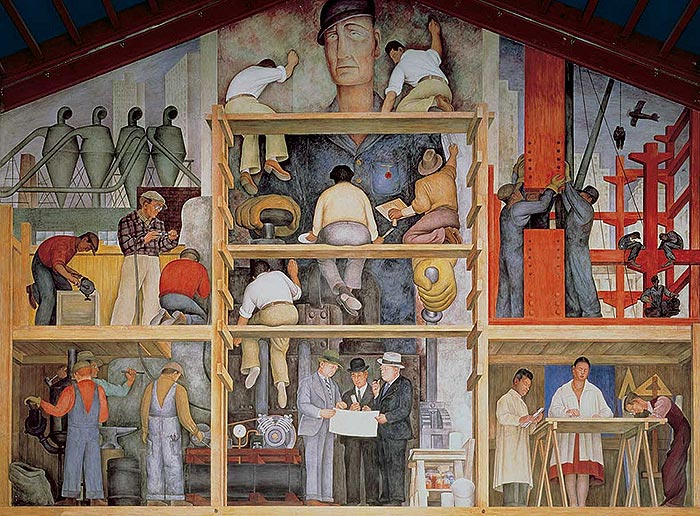
Rivera’s passion and resonance with the working man is still recognizable, in The Making of a Fresco, Showing The Building of a City (1931), he has painted himself into the history of America’s effort to build a great industrial society. There was no quit in the man, nor in his ideals and passions.
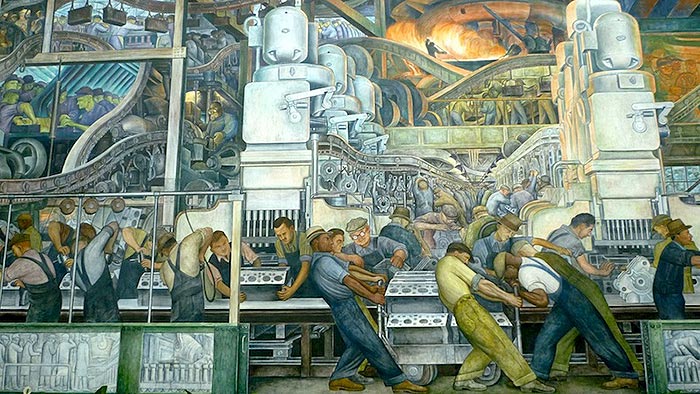
Next stop, the belly of the beast, Detroit and The Ford Motor Company. What better ode to the workers could there be than the industrial life of America at an automobile plant in the midst of the Great Depression.
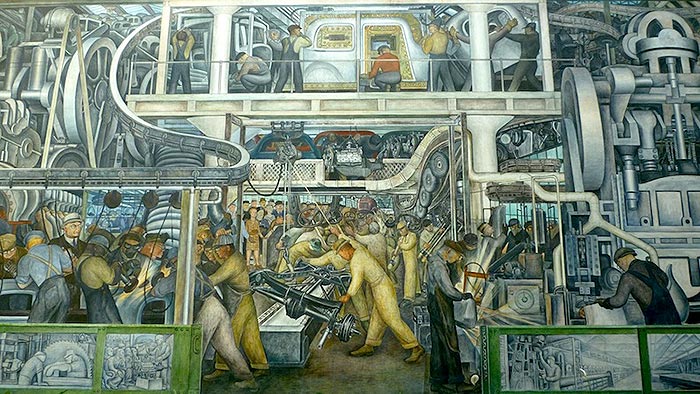
Though Rivera enjoyed tremendous success, he also faced harsh controversy, for both his political beliefs and artistic practice. Though he considered his murals at the Detroit Institute of Arts (1932-33) among his greatest works, his work there faced opposition due to the depiction of men of different races working together. His politics were often disdained and his art was ironically commended, as he said:
“An artist is above all a human being, profoundly human to the core. If the artist can’t feel everything that humanity feels…until he forgets himself and sacrifices himself…if he won’t put down his magic brush and head the fight against the oppressor, then he isn’t a great artist.”
Diego Rivera
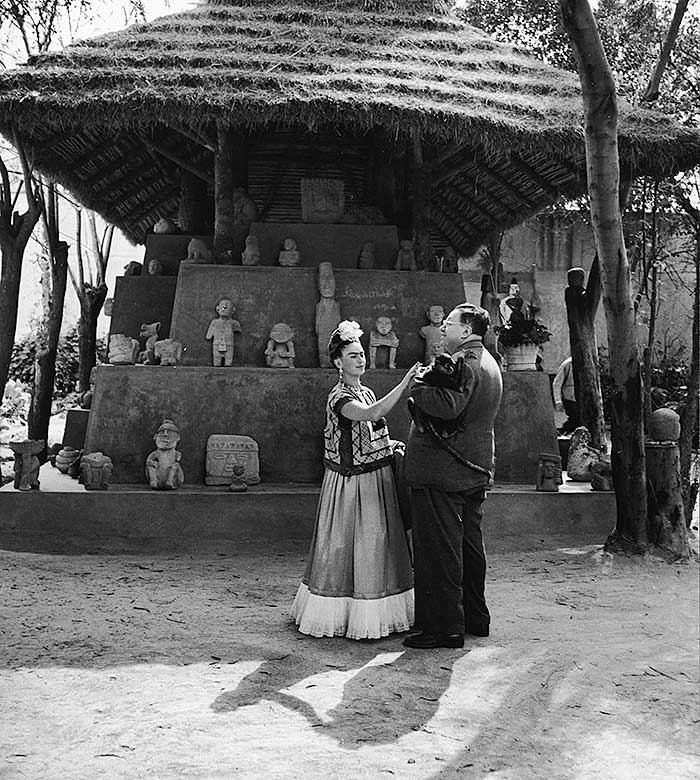
Works Cited
Banco de Mexico Diego Rivera & Frida Kahlo Museums Trust, Mexico, D.F. / Artists Rights Society (ARS), New York
Bravo, Doris. 2018. “Diego Rivera, Man At The Crossroads”. Khan Academy. Accessed October 4.https://www.khanacademy.org/humanities/art-1010/art-between-wars/latin-american-modernism1/a/diego-rivera-man-at-the-crossroads.
“Essay”. 2018. Mtholyoke.Edu. Accessed October 11. http://www.mtholyoke.edu/~klcahoon/borderwebsite/essay.html.
“Diego Rivera: 1886-1957: Artist – Capitalist Art And Communist Politics”. 2018. Biography.Jrank.Org. Accessed September 21. http://biography.jrank.org/pages/3439/Rivera-Diego-1886-1957-Artist-Capitalist-Art-Communist-Politics.html.
Hughes, Robert. 1991. The Shock Of The New. 1st ed. Thames & Hudson Ltd pg. 108
Marquardt, Virginia Hagelstein. “”New Masses” and John Reed Club Artists, 1926-1936: Evolution of Ideology, Subject Matter, and Style.” The Journal of Decorative and Propaganda Arts 12 (1989): 56-75. doi:10.2307/1504057.
Leeds, David. 2011. “The Passion, The Majesty, And The Politics Of Diego Rivera. | A Husk Of Meaning”. Ahuskofmeaning.Com. http://ahuskofmeaning.com/2011/11/the-passsion-the-majesty-and-the-politics-of-diego-rivera/.
“Legacy Of Posada And Influence”. 2014. The Posada Art Foundation. http://www.posada-art-foundation.com/legacy-of-posada.
(Loercher Pazicky 1986) (Quote by Diego Rivera) Foley, Barbara. Radical Presentations: Politics and Form in U.S. Proletarian Fiction, 1929-1941. Durham, NC: Duke University Press, 1993; pg. 65.
Moore, Colin. Propaganda Prints : A history of art in the service of social and political change. London: Bloomsbury Publishing, 2010. Accessed September 19, 2018. ProQuest Ebook Central Pgs. 119-120
Plato.stanford.edu. 2007. Max Weber (Stanford Encyclopedia Of Philosophy). [online] Available at: <https://plato.stanford.edu/entries/weber/>
“prospectus for Dynamo” p. 2 (application to the American fund for public service, 25 March 1925, American Fund for Public Service Records, box 16, reel 11)
Realism, S., n.d. Social Realism Movement Overview. [online] The Art Story. Available at: https://www.theartstory.org/movement/social-realism [Accessed 12 October 2020].
Shapiro, Social Realism: Art as a Weapon (1973) Pg. 3, 15-16
“Social Realism Movement Overview and Analysis”. [Internet]. 2018. TheArtStory.org
Social Realism Movement, Artists And Major Works” 2018)
“The Passion, The Majesty, And The Politics Of Diego Rivera. | A Husk Of Meaning” 2011
Wolfe, Bertram D. “Diego Rivera–People’s Artist.” The Antioch Review 7, no. 1 (1947): 99-108. http://www.jstor.org/stable/4609195.
What do you think? Leave a comment.











Both Frida Kahlo and Diego Rivera are an inspiration to my own work.
I have seen the Diego Rivera gallery at the Detroit Institute of the Arts and they are superb!
There are also many Rivera murals in San Francisco, where I live. They are all amazing.
Rivera is brilliant that wonderful populist realism with echos of the early renaissance.
Khalo is interesting too but she in no way has the greatness of Rivera.
Rivera does not swamp his themes with stiff Marxist cliches , the human and natural joy exude from his canvases and walls.
I think it depends who you ask.
kahlo’s work was intimate, brave and personal – she used images of herself, rather than society, to communicate. As such she is completely different from Rivera, though part of his greatness also was a sense of the personal within the grand sweep of events.
For many women artists Kahlo was a revolution in herself, and took her place in history in such a passionate, wholly female way that she is identified with, and appreciated by many women, particularly those who set out as artists in a time when there were few such female creative icons to look to.
As a woman, and as a disabled woman, her revolution was to transcend both to become not only an artist, but to be known as wholly female, sensual and passionate. It is a tribute to this in her, that we might reference her physical pain and limitations in terms of her creative experience, but rarely if ever see her through the negative stereotyping that being disabled (or being a female artist) has struggled under.
Her art allowed her to rewrite herself in this way, by both her painting and her life, and this in itself is exceptional, albeit in a very different way to Rivera.
“I think it depends who you ask.”
That is an open premise which serves no discussion, it would inevitably elicit many responses but never establish a value.
I support art for everyone but it is not everyone who is that interested or committed or skilled enough to give a balanced judgement on Kahlo/Rivera..
Of course I love Freda Kahlo’s work and life. I understand what she achieved. Her focus on her own life and body are truly remarkable and this makes her a great artist.
The gender of a painter rarely comes into my mind.
Her minute struggles with pigment show some of her limitations as a painter unfamiliar with technique.
Her obsessive detailed inclusions of narrative elements brings sign board painting and naive Sunday painters to mind.
On painterly terms she is no match for Rivera who had embraced modernism mastered cubism and reinvented figurative art with a rich mixture of pop and renaissance form. I am certain she will have known that.
The manipulation of her as a great painter by the art market is obvious.
The international dealers pursuit of higher prices used feminism and her disability and her pretty folk dresses.
There are hundreds of great women artist who we need to know of.
I respect Freda Kahlo and women artists. Kahlo is a great artist I accept that.
I am sure you are correct – I was a sculptor, not a painter, but i have known many female painters, and male ones, who emotionally engaged with her life as well as her work, as one fed the other.
so in some ways we probably agree, but perhaps have slightly different criteria which we deem important
It is this ability to emotionally engage that marks her talent as an artist
The works of art are brilliant. Thank you for drawing attention to their importance.
Several years ago I a holiday in Mexico and visited Diego Rivera’s studio and Trotsky’s house but sadly the Casa Azul was shut for restoration.
Imagine the frustration I felt later in the holiday, when I met a fellow backpacker miles from Mexico City, who’d just bribed the guard and had a private visit on his own.
I too went to Trotsky’s house, in 1990. At that time the ‘museo’ was run by students and once we paid to get in we could just wander. No barriers or museum guards, so I sat myself at Trotsky’s desk and just took in all the history……
I was there in 92. There was a no photography sign in Trotsky’s house but I decided laws were made to be broken and ignored it. Took some nice photographs of his garden and grave. It was amazing to discover that as well as being an international revolutionary, he was also a keen cactus collector, lol! But always regret not going inside La Casa Azul.
Man Controller of the Universe is a 84 year old painting but what it portrays is as relevant as ever.
This piece really highlights the cyclical nature of our history. It’s hard to read this image and not think of the extremely similar political debates going on today in 2020.
I felt connected to this picture, because it reflects human nature, and the fact that it keeps repeating itself, even to this day we are in the same crossroads.
Thank you for the excellent analysis, very educational and enjoyable at the same time.
Diego was in the know and couldn’t talk about that so he painted the truth for those with eyes to see.
Diego was a genius painter, but I am not sure why women liked him so much. Frida liked him because he looked a bit like a women naked, and he incorporated both sexes. He must have just had a lot of charm and appeal.
I am always amazed by the fact that she was far more beautiful and delicate than in her paintings of herself or his; she had a very distorted image of herself and I don’t know what his excuse was. Rivera was a careless glutton both figuratively and literally, he devoured everything that attracted him be it food or women and his desire to hurt them came from a need to test the strength of their devotion. She was like a recherché doll on the arm of a grotesque.
Really good film I watched on Frida Kahlo recently. They need to do one on Diego!
I really enjoyed looking at the artworks included here. They’re so detailed. A really good article! 🙂
We can only imagine what Diego Riviera, if he were alive today, would make of the 21st century and the robotisation of the work force.
Oops. Typo. Rivera.
Wonderful article. Well done.
I’m very envious -would love to see a Rivera exhibition.
I’m researching Diego Rivera and I had no clue into who he was but his paintings are just amazing.
Rivera is very talented. He painted a lot of things that could have been seen today. Workers, oppression, real life events. This guy should’ve been more famous than Frida, and I’m sure his artwork is very expensive now.
For better or worse, Rivera does encapsulate many of the trends of Modernism in the art world, and does cut across a number of artistic mediums.
Thank you for putting this together. It is a shame that a longer more in depth biography cannot be found on this man. He is credited as being one of the most influential and important artist of the twentieth century, yet so little can be found.
Fascinating! I like how Rivera’s paintings are big and colorful and represent spanish culture.
i love the murals of mexico, it’s just so difficult (for me) to work on a small scale. gigantic paintings are so fun
Rivera is one of my favorite collections. Thank you for putting this together.
I love his painted mural for the Rockefeller Center.
Just amazing art. Becomes more relevant every single day.
Great article!
I really enjoyed this passionate essay! Although it left me with the feeling – Social realism good – abstract or lyrical expressionism bad…..(I’m the later)
Can you justify your abstract expressionism?
Actually I should ask, would you put down your abstract expressionist’s brush and head the fight against the oppressor?
I fight oppression in other ways but I’d definitely collaborate.
The application of realism in any context is always fascinating and this is no exception! It left me longing for a cerveza in the JRC… imagine the conversations.
A good essay. I remember seeing several Rivera’s works when I lived in Mexico. For some reason I think I saw one in New York City when I was a kid in the 1950s. Odd how reading your essay brings back some type of memory. I remember reading how Rockefeller commissioned him to do a mural that was subsequently destroyed which you address in your essay. Maybe everyone who grew up in New York City and had some passing knowledge of Rivera knows about that–sort of a collective memory.
Surprisingly never heard of Rivera before, but now gonna kook him up